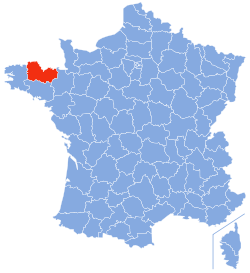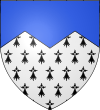Côtes-d'Armor
| Côtes-d'Armor | |||
|---|---|---|---|
| — Department — | |||
|
|||
 |
|||
| Coordinates: | |||
| Country | France | ||
| Region | Brittany | ||
| Prefecture | Saint-Brieuc | ||
| Subprefectures | Dinan Guingamp Lannion |
||
| Government | |||
| - President of the General Council | Claudy Lebreton (PS) | ||
| Area1 | |||
| - Total | 6,878 km2 (2,655.6 sq mi) | ||
| Population (2009) | |||
| - Total | 576,049 | ||
| - Rank | 43rd | ||
| - Density | 83.8/km2 (216.9/sq mi) | ||
| Time zone | CET (UTC+1) | ||
| - Summer (DST) | CEST (UTC+2) | ||
| Department number | 22 | ||
| Arrondissements | 4 | ||
| Cantons | 52 | ||
| Communes | 373 | ||
| ^1 French Land Register data, which exclude estuaries, and lakes, ponds, and glaciers larger than 1 km2 | |||
Côtes-d'Armor (Breton: Aodoù-an-Arvor) is a department in the north of Brittany, in northwestern France.
Contents |
History
Côtes-du-Nord was one of the original 83 departments created during the French Revolution on March 4, 1790. It was created from part of the former province of Brittany. Its name was changed in 1990 to Côtes-d'Armor (ar mor meaning the sea in Breton). The name also has a historical connotation recalling the Roman province of Armorica.
Geography
Côtes-d'Armor is part of the current administrative region of Brittany and is surrounded by the departments of Finistère, Morbihan, and Ille-et-Vilaine, with the English Channel on the north.
Demographics
The inhabitants of the department are called Costarmoricains.
Politics
The Côtes-d'Armor has usually been a left-wing holdout in a historically strongly clerical and right-wing Brittany, due to the department's more anti-clerical nature, especially in the inland area around Guingamp, a former Communist stronghold.
The President of the General Council is Claudy Lebreton of the Socialist Party.
| Party | seats | |
|---|---|---|
| • | Socialist Party | 33 |
| Union for a Popular Movement | 8 | |
| • | Miscellaneous Left | 4 |
| • | French Communist Party | 4 |
| Miscellaneous Right | 1 | |
| MoDem | 1 | |
Culture
The western part of the département is part of the traditionally Breton-speaking "Lower Brittany" (Breizh-Izel in Breton). The boundary runs from Plouha to Mûr-de-Bretagne. The Breton language has become an intense issue in many parts of Brittany, and many Breton-speakers advocate for bilingual schools. Gallo is also spoken in the east and is offered as a language in the schools and on the baccalaureat exams.
See also
- Cantons of the Côtes-d'Armor department
- Communes of the Côtes-d'Armor department
- Arrondissements of the Côtes-d'Armor department
External links
- (French) Prefecture website
- (French) General Council website
- (English) Cotes-d'Armor at the Open Directory Project
- (English) Official Tourist office
|
|||||
